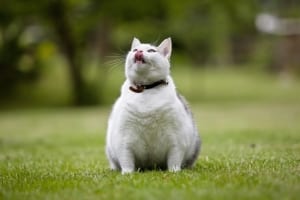
Providing proper nutrition for your pet promotes overall wellness. You should consider your pet’s needs when choosing your pet’s food. Your pet’s age, activity level and body condition all factor into the type of food that should be fed. Body condition is scored on a scale of 1 to 9 and is used to determine if your pet is at his or her ideal weight. A body score of 1 means that your pet is too thin. Conversely, a body score of 9 indicates obesity which raises a list of concerns (a score of 4-5 is ideal). Problems associated with obesity include joint disease, hypertension, diabetes, and shortened lifespan to name a few. While there are several “light” and “weight-control” diets on the market, they are usually intended for weight maintenance rather than weight reduction. If your Veterinarian feels that your pet’s weight is putting his or her health at risk, she may recommend a prescription diet designed to promote weight reduction along with daily exercise. For dogs, swimming or daily walks are sufficient. In cats, exercise can be challenging since they do not go for walks and usually choose to sleep when we are not at home. Try enticing your cat to exercise with toys that require running or jumping like a wind-up mouse or laser pointer.
Treats are often the downfall of every good diet. Reduce the number of treats your pet receives each day and replace the “occasional” treat with carrots or string beans (or, offer kibble from the pet’s daily allowance). Cats love canned pumpkin which is low in calories but also high in fiber so they don’t feel as hungry between meals. It also may be helpful to divide your pet’s meals into several smaller feedings throughout the day.
Increased Poor Health
As we see an increasing number of obese pets we also see an increase in the diseases that are associated with pet obesity, such as:
- type 2 diabetes
- osteoarthritis
- orthopedic disease
- heart and respiratory disease
- high blood pressure
- kidney disease
and many forms of cancer.
On average, overweight dogs and cats live approximately 2.5 years less than those who check in at a healthy weight. Since this can represent one third to a quarter of your pet’s lifespan, it’s significant! And, it raises the importance of being aware that an overweight dog or cat is not a healthy pet.
Body Scoring System
Our goal at Harmony Animal Hospital is first to educate our clients on what is an optimal body weight for your pet. We do this by using a body condition scoring system. The system scores healthy weight pets as a 4-5 on a scale of 1 through 9, with anything over a 5 as overweight. Higher scores are considered obese (>30% over normal body weight).
This scoring is performed on every exam visit, but you may stop in anytime for a weight check and a body condition score. From there, we can determine if weight loss is indicated, what your pet’s optimal body weight is, and ways to achieve that.

